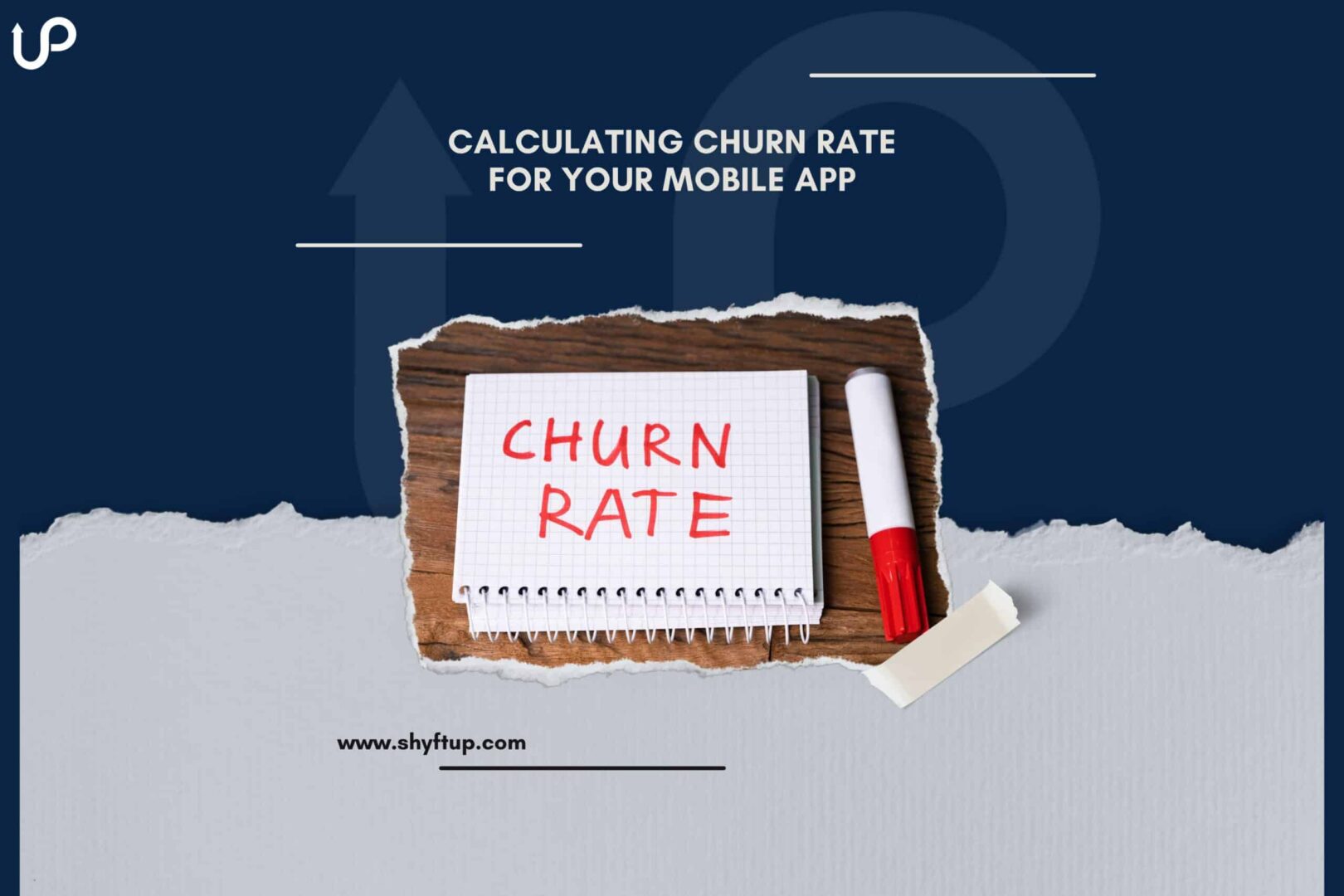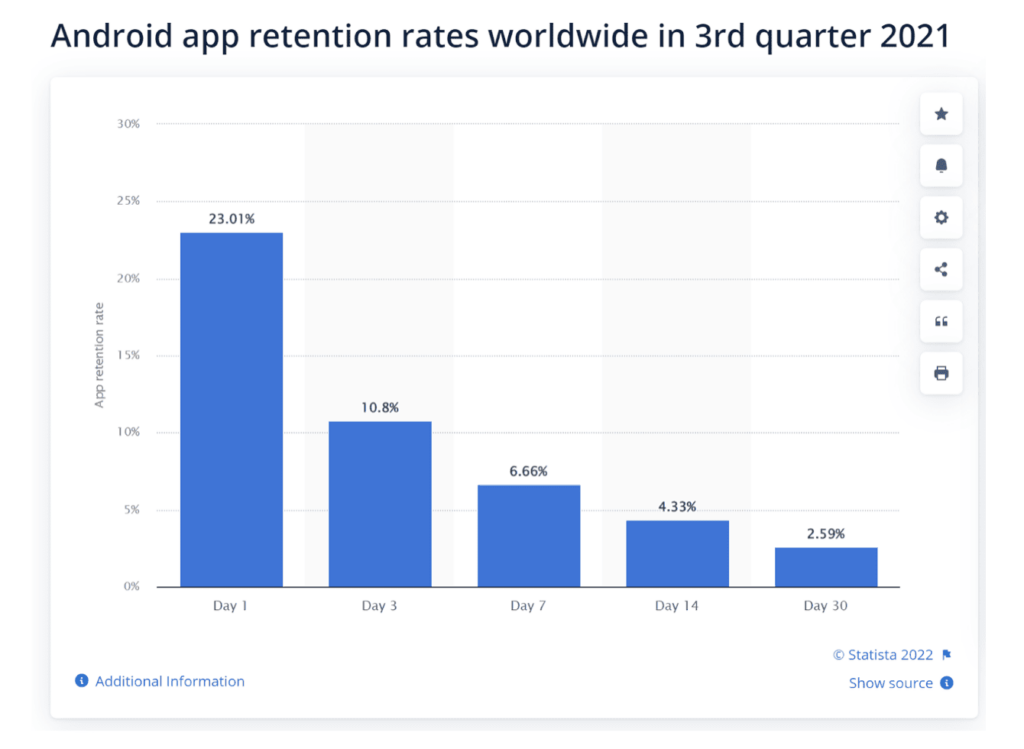
Calculating Churn Rate For Your Mobile App
Calculating the churn rate is an important aspect of your mobile app growth. It allows you to see how many people stop using your app. However, calculating the churn rate can be challenging especially when you don’t have the right data.
Thankfully, in this post, you will learn the following:
- What is the churn rate?
- Why should you monitor the churn rate?
- How to calculate the churn rate?
- How to reduce the churn rate?
So read on to learn more.
What is the churn rate?
The churn rate in mobile apps refers to the percentage of people who stopped using your app for a given period of time. This means that the churn rate lets you know the number of people who uninstall your app and whether your user base is growing or not.
Simply put, you need to have a higher number of retained users than the number of users who abandon your app so that your app grows.
Why should you monitor churn rate?
Churn rate is a scary and painful metric. As this might be the case, it’s a facet of reality you need to face and accept in order to address existing problems.
Here are the reasons why you need to check your churn rate:
- Churn rate tells you whether your app is growing or not.
- Churn rate helps you know the effectiveness of your marketing strategies.
- Churn rate serves as a red flag when user experience is getting worse.
- Knowing your churn rate helps you to be more accurate in your app growth and revenue forecast.
A study was made by Statista to know the global app retention rate. They found out that for the iOS app, after 30 days of installing an app, only 4.13% of users would keep the app. For Android apps, the statistics are much worse. They found out that only 2.6% of users would keep an app they have installed.
If you don’t want these stats to be your reality, you need to religiously monitor your churn rate.
How to calculate the churn rate?
Calculating churn rate is straightforward as long as you have the available data. In essence, here’s what the churn rate formula looks like:

Customers who left / (# of customers at the beginning of a period + # new customers acquired in the same period) x 100 = churn rate
Churn rate example
To better understand this formula, let’s have a churn rate calculation example. Let’s assume these figures are true:
- Customers who left = 250
- # of customers at the beginning of a period = 1,000
- # of customers acquired in the same period = 200
With these figures, here’s what the formula looks like:
250 / (1,000 + 200) x 100 = 20.03%
So, in the example above, losing 250 users and gaining 100 users would lead to a 20.03% churn rate. In this case, there are more people uninstalling the app than people who are installing the app. The growth of the app is negative.
Depending on what details you want to know, the time period in this example can be weekly, monthly, quarterly, or yearly. The shorter the time period the more specific it would be. However, the yearly churn rate can give you a bigger overview of your growth.
What is the average churn rate for mobile apps?
Now, that you got your churn rate, you might be asking, “Is my churn rate normal? Is it too low or too high? What’s the acceptable churn rate?”
According to statistics gathered in the third quarter of 2021, the global churn rate for iOS apps for the first day is 74.35%. On day 7, the churn rate is 90.81%. If that’s not bad enough, on day 30, the churn rate is 95.87%.
Now, that’s for the iOS apps. For Android apps, the stats are worse. On day 1, the churn rate is 76.99%. On day 7, it’s 93.34%. Finally, on day 30, it’s 97.4%.

Image source: Statista
Please understand that the average churn rate varies depending on the category or type of app. However, one thing is undeniable: churn rates are dramatically high across the board.
How to lower churn rate?
Churn rate is a sobering reality check for most apps today. So, instead of denying it, you need to take an honest look at your churn rate and take specific steps to improve it.
So, how can you lower your churn rate? Here are the 5 most important tips:
1. Know the reason why people leave your app
Calculating churn rate is just your initial step to knowing the status of your app. Now that you know people are leaving your app, it’s time to investigate why.
In most cases, the best way to lower your churn rate is to address the reasons people uninstall your app. Once you precisely pinpoint the cause, then it would be easier for you to know the next step.
2. Improve onboarding process
The first impression lasts. That’s why, right off the bat, you need to show your users the core values, benefits, and features of your app.
You can do this during the onboarding process where you guide and walk your users through your app. Make it as simple as possible and limit the number of steps.
The sooner users know about your app’s features and the clearer you explain it to them, the higher your chance to retain them and lower your churn rate.
3. Use push notifications
Push notifications can dramatically improve your user engagement. Statistics show that engaged users will less likely lower your churn rate.
Just be careful and be sure that you send the right number of push notifications so you don’t push away your users. Push notification service providers can help you in this aspect.
4. Personalize your interaction
While it may sound like additional work, personalizing your messages and interactions with your user can actually lower churn rate. When users feel like they are treated as individuals and not just a name in a long list of people, they would most likely continue using your app.
To personalize your interactions, you can use behavioral data such as device type, purchase and search history, and user preference. Definitely, whenever possible, address your users by their names.
5. Enhance user experience
Even if you have the best app concept, if it doesn’t come with a good user experience, then users will leave your app faster than anything else.
Put yourself in the shoes of your users: would you still use an app if it is filled with bugs, poor navigation design, lots of ads, and doesn’t deliver what it promises?
Now, if you can focus on improving how your customers use your app, then they would be more than happy to stay.
Lower your churn rate
Calculating churn rate for your mobile app can easily become complicated if you don’t have the right expertise and tools. Thankfully, you don’t have to do this on your own. ShyftUp is here for you.
ShyftUp is among the leading user acquisition agencies in the world today. They help app developers and marketers to reach their business goals in the most cost effective and quickest way possible. They have the needed experience to help you know your churn rate as well as find ways to lower it.
If you want to improve your app’s growth, then give ShyftUp a try today!
What causes churn?
The top reasons people uninstall an app includes the app is not useful anymore, there’s limited storage, too many ads and/or notifications, and technical issues.
What is a good churn rate?
A good churn rate should be less than 20%. However, the answer may depend on your situation. What’s important is that you aim to have a higher retention rate than your churn rate.
How to track your churn rate?
You can manually calculate and track your churn rate. Nevertheless, this can be too time-consuming. There are useful reporting software and tools for you to use. Both App Analytics and Google Play Console helps you track your churn rate.